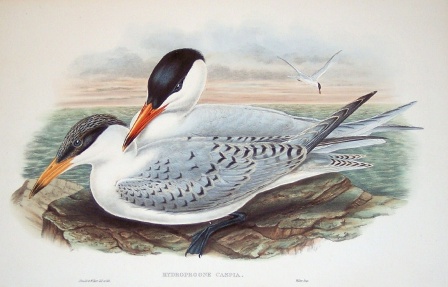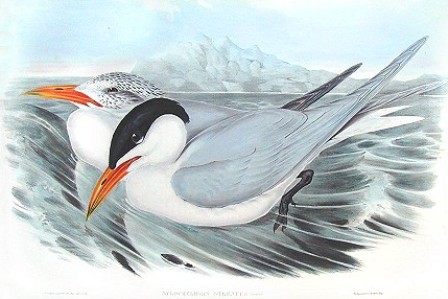
John Gould records, “four or five instances are on record of this large and magnificent tern having been killed in Norfolk and Suffolk; there cannot, therefore, be any doubt as to the propriety of admitting it into the avifauna of Great Britain. It is tolerably common in many parts of the continent of Europe; in Africa and India it is still more abundant. Mr. Swinhoe states it is found all over China; and both Dr. Baird and Mr. Coues include it in the birds of North America. When I wrote my work on the birds of Australia, I considered the Great Tern of Tasmania, from its somewhat larger size, to be distinct; but Jerdon and others are of the opinion that I was in error in doing so. Yielding to their judgement I now place the name strenuus I had assigned to the Antipodean bird as a synonym with those given to the bird found in Asia. Presuming this view of the case to be correct, the range of the species is wide, indeed far wider than I at that time supposed, since Tasmania must now be included in its habitats.
“The Caspian tern is reported to breed annually at Sylt, an island of Denmark, on the coast of Jutland. M.Nilsson says it visits also the mouth of the Baltic, and is seen in the vicinity of the Elbe. It is included by several naturalists in their birds of Germany; Mr Temminck mentions that he has himself killed it, though rarely, on the coast of Holland; and it visits the coasts of France. Mr. Necker and Professor Schinz include this species among the birds of Switzerland, the former quoting four instances of its capture in the vicinity of Geneva; The latter calls it the king of the Sea-swallows, in reference to its very large size. Mr. Temmick says it has been met with and killed on the extensive rocks near Bonifacio, a seaport of Corsica. M. Savi includes it in his work on the birds of Italy; it inhabits the Grecian archipelago; and the Russian naturalists who have lately visited the Caucasus found it in the vicinity of the Caspian Sea, where it was originally found, and whence it received its first name from Pallas. The Caspian Tern has been found at Senegal and at the Cape of Good Hope.
“That the Caspian Tern breeds freely in many parts of Northern Europe we have abundant evidence from the writing of continental authors: but it would appear to be not so numerous in others; for in a note written for this work by Mr. H.E. Dresser, kindly forwarded to me some years since, he says: — “I observed this bird to be breeding sparingly on the small islands in the Gulf of Bothnia. On one of them, outside Uleaborg, called Krassili, I found a nest on the 12th of June, 1861, and shot the bird. The nest was merely a hole scratched in the sand, with a few straws arranged round the inside, and contained only one egg. The mate of the bird I shot continued flying close over our heads the whole time we remained on the island, crying in a hoarse manner from which its Swedish name, ‘Skrautarna’ is derived. I have several times had the eggs from that locality, and have invariably found from my own observations, and also from the peasants, that one pair of birds never suffer another to breed near them. The number of eggs, so far as my experience goes, is more frequently two than three.”
“Jerdon, in his ‘Birds of India’, says: — “this fine Tern is by no means uncommon in most parts of the country, frequenting rivers, jheels, and tanks. It is generally seen alone or in pairs, rarely a few together; and it feeds chiefly on fish and prawns. It does not appear to breed in India, and probably retires to Central Asia for that purpose.” Pallas states that it “only lays two eggs, pale livid in colour, with dusky spots.”
“Having seen much of this bird in a state of nature during my visit to Australia, and, moreover, taken many of its eggs, it may be as well to give a short extract from what I have written on the subject in my ‘Handbook’ to the birds of that country. “The Caspian Tern frequents Southern Europe, India, Africa and all the shores of Australia, but is, perhaps, more numerous on the islands in Bass’s Straits and Tasmania than elsewhere. Its favourite breeding-places are the promontories of small islands, spits of land running out from the shores of the mainland, extensive flats at the entrances of large rivers, and all similar situations. I never observed it breeding in company, and seldom met with more than a pair on an island unless it was of considerable extent. It lays two eggs, on the bare ground, often within a short distance of the water’s edge. No bird watches its eggs with greater assiduity, or defends them with greater courage; and woe betides the unlucky gull or other natural enemy that may wander within the precincts of its breeding-place. I could always discover its eggs by the clamorous, cackling, screeching note which it constantly uttered while flying over the place where they were deposited. The breeding season comprises the months of August, September, and October, during which period the crown of the head is a deep black hue, which gives place to a spotted appearance in other seasons. Both sexes are subject to precisely the same changes; and so much are they alike, that it is only by the somewhat smaller size of the female that they can be distinguished. The extensive development of the wings gives this fine species immense powers of flight; it also plunges into the water with the greatest impetuosity, and brings from beneath the surface fishes of a very considerable size. The eggs are of a stone colour, marked all over with large and small blotches of umber-brown, a great portion of which appears as if beneath the surface of the shell; they are about two inches and five eighths long by one inch and three quarters broad.”
“The Plate represents an adult male, and a young bird in a state of change, of the size of life.”

Other common names: —
Hydroprogne caspia
Description: —
Native bird
51 cm, 700 g. Very large grey tern with massive red bill tipped with black and yellow. Adult has black cap when breeding, flecked with white when not breeding, legs black: juvenile browner cap, bill and legs more orange. Call a harsh Kaa.
Where to find: —
In New Zealand they breed on both islands along the coast. They may be seen fishing just beyond the shoreline.
Youtube video —
Credit for the photograph: —
Illustration description: —
Gould, John, Birds of Great Britain, 1862-73.
Gould, John, Birds of Australia, 1840-48.
Reference(s): —
Heather, B., & Robertson, H., Field Guide to the Birds of New Zealand, 2000.
Gould, John, Birds of Great Britain, 1862-73
Page date & version: —
Saturday, 17 May, 2014; ver2009v1

